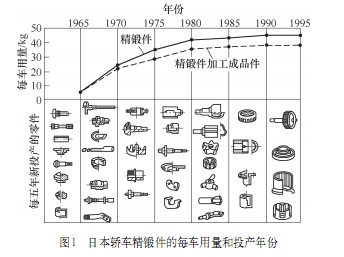1. Application prospects of cold precision forging technology
In the developed countries, the cold forgings on each car have more than 50kg and more than 70 varieties, including cross shaft, spline shaft, cylindrical gear, bevel gear, constant speed drive shaft, inner star wheel, bell shell, trigeminal shaft, inner Splined sleeves, timing ring and other parts (excluding standard parts and fasteners). The cold forgings on each car in China are only about 20kg. Compared with the annual output of nearly 20 million vehicles, the huge market rigidity demand determines that China's cold precision forging products have a wide variety both in terms of variety and quantity. Expansion capacity. Figure 1 shows the per-vehicle usage and production year of Japanese car precision forgings.

2. The development of cold precision forging technology in China
Cold precision forging technology has experienced three developments in large-scale production and application in China:
(1) First development
In the 1960s and 1970s, Shanghai Jiaotong University was the mainstay of the cold forging technology for the first time in China (mainly cold extrusion), producing sewing machines, bicycles, watches and other parts and a small number of automotive parts. The earliest batch production of automobile cold forgings in China is the piston pin, ball pin and ball seat of the engine, and the shape is relatively simple (the cross section is circular). The technical level of cold forging technology is very different from the advanced level of foreign countries. During this period, China's modern automobile industry has not yet started, but for bicycle countries, it has been able to mass-produce bicycle discs, center shafts, fixed bowls, and adjustment bowls by cold forging.
(2) Second development
In the 1980s and 1990s, the Armed Forces Industry No. 59 Research Institute (formerly Liu Er Institute), Dafeng Bicycle Flywheel Factory (now Jiangsu Senwei Precision Forging Co., Ltd.), Chongqing Huajiang Machinery Factory, etc. Precision plastic forming processes such as pressing, swinging, rolling and fine punching produce large-scale production of motorcycle and automobile tooth parts. This period is a period of rapid development of China's motorcycle industry. The output is quickly over 10 million units. The localization requirements of parts and components have led to the mass production of related cold precision forging products. The most typical cold forgings are the main pair in the transmission. Shaft and combination gears, face tooth ratchets in the recoil starter and starter shaft. These kinds of tooth cold forgings should be the largest cold forging products currently produced in China.
(3) Third development
In the late 1990s, China's modern automobile industry has developed rapidly, and the output has soared, which has promoted the simultaneous improvement of process technology and process equipment of parts and components enterprises. Several well-known precision forging enterprises in China have refined their products in Jiangsu, Zhejiang and Shanghai. Forging companies (such as Jiangsu Pacific Precision Forging Technology Co., Ltd., Jiangsu Spaceship Co., Ltd., Jiangsu Senwei Precision Forging Co., Ltd., Shanghai Naifu Fu Transmission Shaft Co., Ltd.) mainly introduce foreign advanced equipment and production lines, and apply occlusion forging, Advanced processes such as split forging, hot (warm) precision forging + cold finishing combined forming, flow control forming (FCF), etc., to produce complex-shaped parts for automobiles, such as bell-shaped shells, three pin bushings, three-pronged shafts, cross shafts, inner Star wheel, synchronous gear ring, etc., so that the current level of precision forging technology in China has approached or partially reached the advanced level in foreign countries.
Antioxidant 3114 cas: 27676-62-6
Physical Properties: White Crystalline Powder Assay: ≥98%
Melting range: 218-224℃ Ash: ≤0.006% Light Transmittance:425nm≥95% ,500nm≥97% Volatiles: ≤0.5%
Applications:The product is a kind of tri-function group phenolic antioxidant, without pollution and coloring up. Dependent on high molecular weight and melting point, it has low volatility, low transferring,and good water extraction resistance, white equips plastics with resistance to thermo-oxidation and light-oxidant. AT-3114 suits for PE,PP,PS,ABS,nylon,PVC,PU,cellulose and synthetic rubber, especially effective for polyolefin.When used with UV absorbent and phosphite ester,a synergistic effect can be reached, thus enhancing the thermo-stability and light stability.
This product can be used to contact food polyolefin products(contact fatty and non-fatty foods).The photo-thermal stability can be further improved by synergism with UV absorber or phosphates.It can prevent the aging of the polymer by heat and oxidation, and also has anti-light property. It is mainly used as an antioxidant for polypropylene and polyethylene, which has the functions of heat and light stabilization. There are synergistic effects with photostabilizers and adjuvant antioxidants. The product is low in toxicity. POLYOLEFIN products available for food exposure at a dosage not exceeding 15 % of the main materials.
Packing: Net 25kg/drum,cardboard boxes with plastic liners;or as required.
Storage: Keep away from moisture and overheat.
Chemical name:1,3,5-Tris(3,5-di-tert-butyl-4-hydroxy benzyl)-s-triazine-2,4,6-(1H,3H,5H)trione
Introduction: The product is soluble in solvents like acetone,chloroform and amide, and insoluble in alkane and alcohols. Flash point:289.4℃kindling point:302℃.
High Melting Point Antioxidant
High Melting Point Irganox,Rubber And Resin Irganox,High Melting Point Antioxidant Powder
Tianjin Xindafeng Import & Export Trade Co., Ltd. Tangshan KeAo chemical additives Co., Ltd. , http://www.tskaantioxidant.com